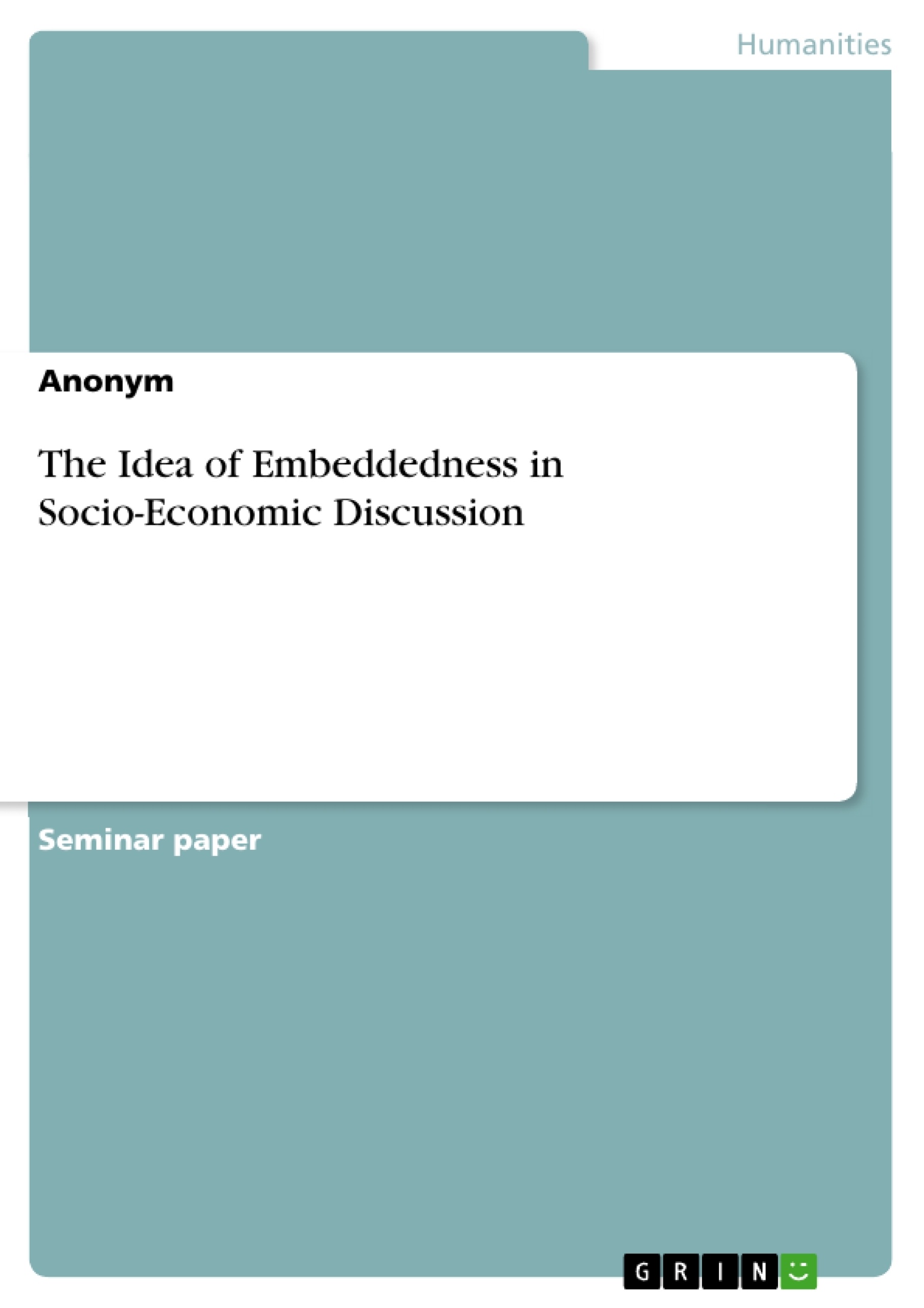The concept of embeddedness has passed through many stages of socio-economic debate since its first significant use in Polanyi`s work "The Great Transformation". The term has been used in connection with old sociological questions such as the social order, but also in connection with newer topics such as network analysis. A central context here is the connection between non-economic and economic. The concept of embeddedness is thus something overarching between these fields and represents exchange in the form of mutual interpenetration. The term is used at various levels of abstraction, both at the system-structural level and at the level of the smallest social actor, the individual.
In the following, an attempt will be made to understand the term more closely using the consideration of 3 economic sociologists and to identify commonalities as well as differences. To this end, the focus of this paper is primarily on the connection between non-economic and economic. In the next part, the theoretical concepts of Karl Polanyi, Talcott Parsons and Mark Granovetter are presented, considering comparable factors. It should be noted at this point that no term for embeddedness is presented for Parsons. Instead, the term interpenetration will be introduced. The reason is that Parsons does not use the term embeddedness literally, but in the literature embedding and interpenetration are put into relation (one example is Jens Beckert 2003). Because of this, this work deals with the concept of embedding, but also deals with comparable concepts. The quintessence lies in the theoretical concretization. Since Granovetter's concept of embeddedness has been discussed the most, in point 3 there is scientific reception of Granovetter's embeddedness in comparison with Parsons and Polanyi by Jens Beckert and Jan Sparsam.
Table of Contents
- Introduction
- Embeddedness (Interpenetration)
- Polanyi's Embeddedness
- Parsons Interpenetration
- Granovetter's Embeddedness
- Comparative Evaluation in Scientific Discussions
- Comparing Polanyi's and Granovetter's Embeddedness
- Granovetter's Embeddedness vs. Parsons Interpenetration
- Discussion and Conclusion
- References
Objectives and Key Themes
This paper aims to analyze the concept of embeddedness within socio-economic discussions by comparing the theoretical frameworks of Karl Polanyi, Talcott Parsons, and Mark Granovetter. The focus is on understanding the interplay between economic and non-economic factors and how these different theorists conceptualize this relationship.
- The evolution and various interpretations of the concept of embeddedness.
- A comparative analysis of Polanyi's, Parsons', and Granovetter's approaches to embeddedness.
- The relationship between economic and non-economic spheres.
- The application of embeddedness at different levels of social analysis.
- Scientific reception and discussion of Granovetter's concept of embeddedness.
Chapter Summaries
Introduction: This introductory chapter sets the stage for the paper by outlining the historical development and multifaceted nature of the concept of embeddedness within socio-economic discourse. It highlights the concept's relevance to both classic sociological questions of social order and contemporary topics like network analysis. The chapter emphasizes the overarching nature of embeddedness in bridging the economic and non-economic realms, operating at various levels of abstraction from individual actors to systemic structures. The paper's methodology is established, focusing on a comparative analysis of Polanyi, Parsons, and Granovetter's perspectives, with a specific focus on the interplay between economic and non-economic aspects. The chapter also introduces the term "interpenetration" as a parallel concept to Parsons' work, clarifying its relationship to the concept of embeddedness.
Embeddedness (Interpenetration): This chapter delves into the theoretical underpinnings of each author's concept of embeddedness (or interpenetration in Parsons' case). It provides a detailed explanation of their relevant theories to lay a solid foundation for subsequent comparisons. Each theorist's unique approach to the concept and its implications are presented. This lays the groundwork for evaluating the similarities and differences between their theoretical frameworks, facilitating a deeper understanding of the nuances within the concept of embeddedness.
Keywords
Embeddedness, Interpenetration, Socio-economic, Polanyi, Parsons, Granovetter, Network Analysis, Economic Sociology, Social Order, Market Economy, Non-economic Factors.
Frequently Asked Questions: A Comprehensive Language Preview
What is the main topic of this paper?
The paper focuses on analyzing the concept of "embeddedness" within socio-economic discussions. It compares the theoretical frameworks of Karl Polanyi, Talcott Parsons, and Mark Granovetter to understand how economic and non-economic factors interact.
What are the key themes explored in the paper?
Key themes include the evolution and interpretations of embeddedness, a comparative analysis of Polanyi's, Parsons', and Granovetter's approaches, the relationship between economic and non-economic spheres, the application of embeddedness at different social levels, and the scientific reception of Granovetter's work.
Which theorists' works are compared in this paper?
The paper compares the perspectives of Karl Polanyi, Talcott Parsons (using the parallel concept of "interpenetration"), and Mark Granovetter on the concept of embeddedness.
What is the paper's methodology?
The paper employs a comparative analysis of the three theorists' perspectives, focusing on how they conceptualize the interplay between economic and non-economic aspects of embeddedness.
What are the chapter summaries?
The Introduction sets the stage, outlining the historical development and multifaceted nature of embeddedness. The Embeddedness (Interpenetration) chapter delves into the theoretical underpinnings of each author's concept, providing detailed explanations for subsequent comparisons. The paper also includes sections on Comparative Evaluation, Discussion and Conclusion, and References.
What are the key concepts discussed?
Key concepts include embeddedness, interpenetration (Parsons), socio-economic factors, network analysis, economic sociology, social order, and the interplay between economic and non-economic factors.
What is the purpose of the paper?
The paper aims to provide a comprehensive analysis of the concept of embeddedness, clarifying its various interpretations and applications across different theoretical frameworks.
What is included in the provided preview?
The preview includes the title, table of contents, objectives and key themes, chapter summaries, and keywords.
What is the intended audience for this paper?
The intended audience appears to be academic researchers and students interested in sociology, economic sociology, and related fields.
- Quote paper
- Anonym (Author), 2021, The Idea of Embeddedness in Socio-Economic Discussion, Munich, GRIN Verlag, https://www.grin.com/document/1026472




